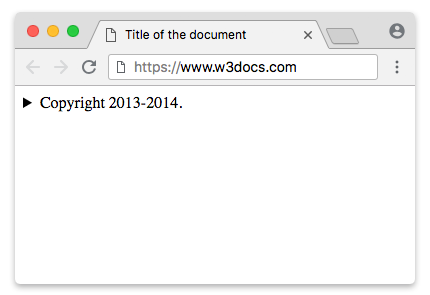The <summary> tag is used to define the visible header for the <details> element. By clicking on the header the user can view/hide the information.
The <summary> element always should be the first element inside a <details> tag. When you click on the summary, the parent <details> element is switched open or closed. Then the toggle event is sent to <details>, which can be used to inform you when the state change occurs.
If the first child of the <details> element isn’t a <summary> element, a default string will be used as a label of the disclosure box.
The default style for <summary> tags contains the CSS display property with the “list-item” value allowing to change the icon that is displayed as a disclosure widget. If you want to remove the disclosure triangle, you can use display: block.
The <summary> tag is one of the HTML5 elements.
Syntax
The <summary> tag comes in pairs. The content is written between the opening (<summary>) and closing (</summary>) tags.
Example of the HTML <summary> tag:
<!DOCTYPE html>
<html>
<head>
<title>Title of the document</title>
</head>
<body>
<details>
<summary>Copyright 2013-2014.</summary>
<p>W3docs. All rights reserved.</p>
<p>The content of the website is the property of W3Docs.com.</p>
</details>
</body>
</html>Result

Attributes
The <summary> tag supports Global Attributes and the Event Attributes.
How to style <summary> tag?
Common properties to alter the visual weight/emphasis/size of text in <summary> tag:
- CSS font-style property sets the style of the font. normal | italic | oblique | initial | inherit.
- CSS font-family property specifies a prioritized list of one or more font family names and/or generic family names for the selected element.
- CSS font-size property sets the size of the font.
- CSS font-weight property defines whether the font should be bold or thick.
- CSS text-transform property controls text case and capitalization.
- CSS text-decoration property specifies the decoration added to text, and is a shorthand property for text-decoration-line, text-decoration-color, text-decoration-style.
Coloring text in <summary> tag:
- CSS color property describes the color of the text content and text decorations.
- CSS background-color property sets the background color of an element.
Text layout styles for <summary> tag:
- CSS text-indent property specifies the indentation of the first line in a text block.
- CSS text-overflow property specifies how overflowed content that is not displayed should be signalled to the user.
- CSS white-space property specifies how white-space inside an element is handled.
- CSS word-break property specifies where the lines should be broken.
Other properties worth looking at for <summary> tag:
- CSS text-shadow property adds shadow to text.
- CSS text-align-last property sets the alignment of the last line of the text.
- CSS line-height property specifies the height of a line.
- CSS letter-spacing property defines the spaces between letters/characters in a text.
- CSS word-spacing property sets the spacing between words.
Browser support
|
|
|
|
|
|---|---|---|---|
| 12+ | 49+ | 6+ | 15+ |
Practice Your Knowledge
Quiz Time: Test Your Skills!
Ready to challenge what you've learned? Dive into our interactive quizzes for a deeper understanding and a fun way to reinforce your knowledge.